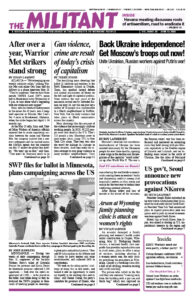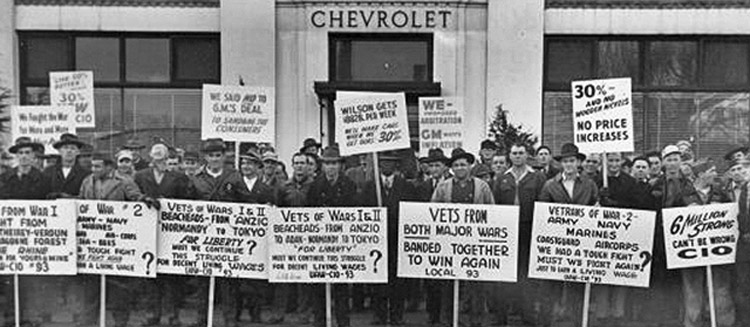Letters from Prison: A Revolutionary Party Prepares for Post-WWII Labor Battles by James P. Cannon, a founding leader of the Socialist Workers Party, is one of June’s Books of the Month. Cannon, with 17 other cadres of the SWP and the Minneapolis Teamsters union, was framed up under the thought-control Smith Act. They were convicted in 1941 and sent to prison three years later for opposing Washington’s imperialist aims and entry into the Second World War. Cannon’s letters take up questions of program and perspectives key to preparing a communist party for explosive labor struggles after the war. The excerpts on expanding use of the Militant are from letters written from federal prison in Sandstone, Minnesota, in December 1944. Copyright © 1973 by Pathfinder Press. Reprinted by permission.
What kind of a paper will best serve the needs of the new party in the next period which lies immediately before us? We used to think, or rather take for granted, that as we broke out of the narrow propaganda circle and began to get a hearing from the workers, we should aim at changing the weekly into a daily. …
It was also assumed that, as the paper became a “mass” paper, it would be obliged to adapt itself to the political understanding of the average, if not to the lowest common denominator, among its new readers; leaving the more complicated political and theoretical explanations to the monthly magazine. …
But what we have to do next is to reach more and more new people, catch their attention at the moment when they are just awakening from political indifference, and try to reach them with our message regularly. A big national weekly is ideally suited to this task. And this is a project within our means and potential resources, financial and physical. The whole situation cries out for concentration on the task of developing The Militant into an eight-page national paper, published at the cheapest price possible so as to facilitate not merely the expansion but the multiplication of its present circulation; a weekly which is not just another radical paper but the national paper, dominating the radical labor field.
This is our central task. It is within our means and resources. And its successful execution will help, not hinder, the symmetrical development of all other departments of party work — organization, publishing house and educational system. …
The decision to reduce the subscription price to $1 per year was an important and necessary step at the present time. The objection that this is “too cheap” would be well grounded only if it could be shown that we can’t afford to cut the price. …. In any case the experiment will be a useful experience.
The principle that readers must pay for the paper is a sound one; people are inclined to put a higher value on things they pay for, even if it is a very small amount, than on throwaway sheets which they get for nothing. I believe all experienced organizers recognize that throwaway leaflets are the most expensive and least productive of all propaganda methods. That, however, does not prevent some people, who have not yet formed the habit of thinking and weighing experience, from periodically making excited proposals for free leaflet distribution as a panacea. But, nevertheless, experience has also shown that it is the principle of paying, not the amount paid, that is most important. The two should not be confused and lumped together. …
The [New York] Times circulation is subsidized by advertising revenue. We must do the same thing, on a more modest scale, from voluntary contributions. At present, this subsidy permits us to sell the paper for $1 per year. If later we can make it cheaper yet, we will do so. We want circulation! …
I anticipate a great increase of fifty-cent, six-month subs when the new rate goes into effect. The difference in price does not mean so much and is not necessary for old Militant patriots and radicals who want to keep track of us. But for new people who are just beginning to be interested — and these are precisely the ones we are most anxious to reach — the cheaper price can easily be decisive in three cases out of four. …
Viewing The Militant as a tool, I should like to refine the definition by saying that, in the next period, it must serve us as a combination tool which can be used on several different jobs. I believe this qualification is very important.
The paper, for the first time, is getting a good reception from masses of workers without previous political education or interest. The majority of its readers at the present moment are new people, and it is to be expected that this majority will become larger. The Militant must serve this new audience, adapt itself to the stage of their political development, under penalty of losing their interest. …
For the benefit of the new reader we must tell the history of the movement over and over again, dramatizing the great events and personalities of the past, in order to build up one of the most powerful supporting ideas any movement can have — the idea of tradition. …
The Militant must strive to be a combination paper; a paper which interests and serves the needs of the new reader who picks it up for the first time, the reader who is beginning to think … without yet thinking about the party, and the educated party militant — all at the same time. If we get this conception clearly in our heads we will be able to avoid some of the most costly errors of the past and close big gaps through which many thousands of potential socialists slipped away from the movement in the past.
We can only afford to publish one paper. And we must address ourselves to the politically educated as well as to the uninitiated. And we must also remember that between the best posted party member of years of study and experience and the new reader there are numerous strata in different degrees of development. And we must publish a paper for all of them. Most important of all, we must bear in mind that the new reader does not remain a new reader all his life. The average intelligent worker quickly absorbs the few simple ideas which attracted him to the paper in the first place. Then he begins to feel the need of more substantial food.


